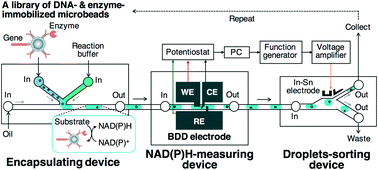Microfluidic screening system based on boron-doped diamond electrodes and dielectrophoretic sorting for directed evolution of NAD(P)-dependent oxidoreductases†
Abstract
We report the development of a micro total analysis system (μTAS) based on electrochemical measurements and dielectrophoretic sorting for screening of NAD(P)-dependent oxidoreductases. In this system, the activity of enzymes immobilized on microbeads, together with their encoding DNA, can be measured with a boron-doped diamond (BDD) electrode in each compartment (∼30 nL) of the microfluidic system. The 30 nL droplets containing microbead-displayed genes of enzymes with higher activity can then be recovered by dielectrophoretic sorting. Previously, we developed the NAD(P)H-measuring device containing the BDD electrode for high-throughput measurement of the activity of NAD(P)-dependent oxidoreductases. In this study, we fabricated an encapsulating device and a droplet-sorting device for nanoliter-size droplets, for the first time, and then combined these three devices to construct a μTAS for directed evolution of NAD(P)-dependent oxidoreductases. We confirmed that this system works by proof-of-principle experiments and successfully applied this system for screening of randomized libraries of NAD-dependent dehydrogenases.



 Please wait while we load your content...
Please wait while we load your content...